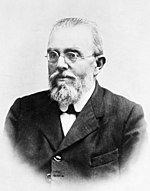Giovanni Battista Grassi (27 March 1854 – 4 May 1925) was an Italian physician and zoologist, best known for his pioneering works on parasitology, especially on malariology. He was Professor of Comparative Zoology at the University of Catania from 1883, and Professor of Comparative Anatomy at Sapienza University of Rome from 1895 until his death. His scientific contributions covered embryological development of honey bees, on helminth parasites, the vine parasite phylloxera, on migrations and metamorphosis in eels, and on termites. He was the first to describe and establish the life cycle of the human malarial parasite, Plasmodium falciparum, and discovered that only female anopheline mosquitoes are capable of transmitting the disease. His works in malaria remain a lasting controversy in the history of Nobel Prizes, because a British army surgeon Ronald Ross, who discovered the transmission of malarial parasite in birds was given the 1902 Nobel Prize in Physiology or Medicine. But Grassi, who demonstrated the complete route of transmission of human Plasmodium, and correctly identified the types of malarial parasite as well as the mosquito vector, Anopheles claviger, was denied.
Grassi was the first to demonstrate the life cycle of human dwarf tapeworm Taenia nana, and that this tapeworm does not require an intermediate host, contrary to popular belief. He was the first to demonstrate the direct life cycle of the roundworm Ascaris lumbricoides by self-experimentation. He described canine filarial worm Dipetalonema reconditum, and demonstrated the parasite life cycle in fleas, Pulex irritans. He invented the genus of threadworms Strongyloides. He named the spider Koenenia mirabilis in 1885 after his wife, Maria Koenen. He pioneered the foundation of pest control for phylloxera of grapes.










